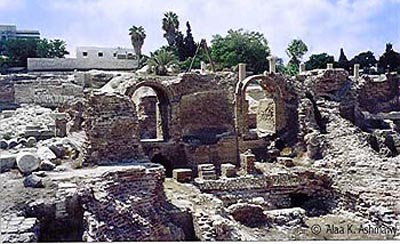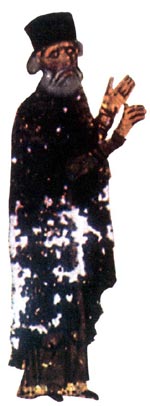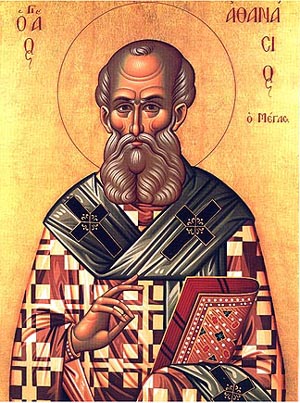 |
The Saint of the Day
St. Alexander of Alexandria, February 26
Prof. Plinio Corrêa de Oliveira
Biographical selection:
St. Alexander was made Patriarch of Alexandria in 313. He was a disciple of the Patriarch of Alexandria St. Peter the Martyr, and had heard the warnings the great Bishop made in prison about the deacon Arius. St. Alexander led an untiring battle against this heretic, preparing the way for St. Athanasius.

Above, modern Alexandria. It was a prominent intellectual, political and economic metropolis in the ancient world. Below, ruins of its Roman amphitheatre from the time of St. Alexander.

|
Arius was a tall man of a grave imposing appearance. He attracted confidence by his amiable manner and agreeable conversation. He lived austerely, assumed a penitent air, and showed an apparent zeal for religion. With a broad but superficial knowledge of profane literature and the ecclesiastical sciences, he was a subtle and persuasive dialectician. However, under this exterior show of virtue was a man of melancholy, turbulence, ambition and a taste for novelties. After he was ordained priest and charged with teaching Scriptures, he could not contain his vanity and titled himself illustrious. After the death of St. Achillas, Bishop of Alexandria, Arius aspired to his see. When St. Alexander was chosen for it, Arius became his enemy. It was about this time that Arius began to teach his bad doctrine and recruit followers.
St. Alexander, concerned about the spreading of this heresy and finding Arius obstinate and incorrigible, excommunicated him from the Diocese of Alexandria. The heretic went to Palestine where he received the support of various bishops, especially Eusebius of Nicomedia. There he began a campaign of intrigues against his adversaries.
The Council of Nicaea in 325 condemned Arius and his doctrines. In that famous assembly of Bishops, one of the high luminaries was St. Alexander. St. Athanasius, who had accompanied St. Alexander, was also present as a deacon. St. Alexander returned to Alexandria, where he died several years later, after naming St. Athanasius as his successor. Having dedicated his life to gloriously fighting in defense of the Church, he delivered his soul to the Lord in 328.
Comments of Prof. Plinio:
It is noteworthy that this selection speaks more about Arius than St. Alexander. The description of the heresiarch is well done, because all the psychological facets are coherent and portray the typical hypocrite of that time who pretended to be a pious religious.

Arius was a tall figure with an imposing air
|
Today many modern people have a favorable view of a Bishop with a modern car, perhaps a sports car, or a Bishop who takes on a communist look in order to give the impression that he is favorable to the poor. In that time the heretics used to assume conservative airs. Arius was a tall figure with an imposing air – I am reminded of some Eastern schismatic priests with their strong physiques, beards, vigorous airs, and those hard black hats. Further, he had an amiable presence, and was well versed in Scriptures and the sacred sciences. But deep down he was steaming with ambition and excesses. Here you see the hypocrite. In epochs when good prevails, the hypocritical pays tribute to good.
This appearance of sanctity made the combat of St. Alexander against Arius more difficult. Arius fooled many people. We will see this type of evil with the Antichrist, who will also appear to be a saint. In such cases, the one who attacks such pseudo-saints look like a bad man. This resource to hypocrisy inverts everything: the evil looks good and vice-versa. So, many people would have thought that St. Alexander was bad because he was attacking Arius, which made for a very difficult fight. St. Alexander had to fight hard to condemn Arius and expel him from Alexandria. Arius ended by becoming Archbishop of Constantinople. He died during a procession going to the Cathedral supposedly to be readmitted to communion to the Church. It was an extraordinary death where his stomach exploded, and his intestines and organs spilled out.
St. Alexander was the opposite of Arius. He had been preceded by St. Achillas and his secretary was St. Athanasius. The great St. Athanasius was so anti-Arian that even when all the other Bishops and even a Pope became Arians, he stood alone defending orthodoxy. The persecution he suffered was so difficult that for a while he had to hide himself in the sepulcher of his parents and live there.

St. Athanasius carried on the work of St. Alexander
|
So we can see the growing chain of saints: St Achillas who was succeeded by St. Alexander, who was more than the former. Then St. Alexander was succeeded by St. Athanasius, who was greater still in the fight against Arianism. We can see that Divine Providence prepared a kind of genealogy of saints in the See of Alexandria that was completed with the incomparable St. Athanasius who gave the Church the final victory against Arianism.
These actions of Divine Providence have an extraordinary architectonic beauty, which is the most beautiful thing in History. God so arranges that one saint should succeed another, one good movement generates another. Even if at times it can appear that the good cause is defeated, it ends as victorious through the prayers and intercession of Our Lady.
We can learn a good lesson from the life of St. Alexander and the fight against Arianism. That is, we should not be fooled by the appearance of sanctity of many religious progressivists and their success in some pious milieus. Also, we should not become discouraged when these same people call us proud and lacking charity because we maintain a position consistent with Catholic principles. This kind of accusation should not bother us. Just as Our Lady made the apostolate of St. Achillas, St. Alexander and St. Athanasius fruitful amidst the difficult battles and persecution the good cause suffered, so also will she make our apostolate grow, and give us the necessary means to establish her Reign. Let us ask St. Alexander to help us in this fight


  |
|
Prof. Plinio Corrêa de Oliveira | |
The Saint of the Day features highlights from the lives of saints based on comments made by the late Prof. Plinio Corrêa de Oliveira. Following the example of St. John Bosco who used to make similar talks for the boys of his College, each evening it was Prof. Plinio’s custom to make a short commentary on the lives of the next day’s saint in a meeting for youth in order to encourage them in the practice of virtue and love for the Catholic Church. TIA thought that its readers could profit from these valuable commentaries.
The texts of both the biographical data and the comments come from personal notes taken by Atila S. Guimarães from 1964 to 1995. Given the fact that the source is a personal notebook, it is possible that at times the biographic notes transcribed here will not rigorously follow the original text read by Prof. Plinio. The commentaries have also been adapted and translated for TIA’s site.
|
Saint of the Day | Home | Books | CDs | Search | Contact Us | Donate

© 2002- Tradition in Action, Inc. All Rights Reserved
|
 |

|